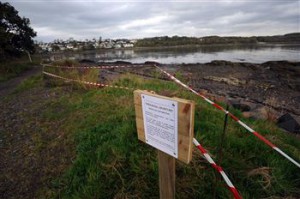
A RADIOACTIVE beach is so contaminated that Ministry of Defence (MoD) scientists refuse to analyse samples from it.
They fear that handling material from Dalgety Bay in Fife could give them cancer.
The startling admission was revealed in minutes of a meeting by the Dalgety Bay Risk Assessment Group back in 2009.
The meeting was designed to get the Scottish Environmental Protection Agency (Sepa) and the MoD to agree on ways to assess the health hazards of the pollution but failed after several disagreements and the group has not met again.
The revelation comes just days after Sepa found 33 radiation particles on the foreshore – just a few metres from a footpath.
Officials say one was small enough to be swallowed by a child and was radioactive enough to be “cause for concern”.
Scandalous
Last week parts of the beach were closed to the public after Sepa uncovered a large lump of radioactive metal on the site. It was discovered to be 10 times more radioactive than anything previously found at Dalgety Bay
The meeting minutes reveal that MoD scientists are “not particularly keen” to handle the contamination, a position condemned last night as “contradictory”, “unacceptable” and “scandalous”.
At the meeting, Sepa’s radiation expert, Paul Dale, argued that the particles needed to be properly analysed.
But the principal scientist at the MoD’s Hampshire laboratory, Rob Brown (RB), disagreed.
The minutes record: “RB stated that MoD analysts are not particularly keen to work with these samples due to concerns over dose rates from high-activity samples. RB also advised that cost was an issue.”
Speaking yesterday, Mr Dale said: “It was unbelievable.
“He was saying that it would be hazardous for scientists, but not for children on the beach. That’s contradictory.”
Scottish Environment Secretary Richard Lochhead called the revelation “disturbing” and vowed to take the issue up with the Defence Secretary, Phillip Hammond.
Priority
“Foot dragging by MoD officials must not continue to delay the final clean up,” he said.
“Public safety is the number one priority and the MoD must be completely open and transparent. We absolutely must get to the root cause of this repeated contamination of Dalgety Bay.”
The MoD did not dispute the content of the minutes but did not accept that the pollution could be harmful to the public.
Officials said they supported the work done by Sepa to remove the material and the spokesman said it had a “serious commitment” to helping find a long-term solution.
The first radioactive particles were found on the beach in 1990 and 1800 have been removed since then. Since September Sepa have removed more than 100 from near the footpath and from around the slipway of a local yachting club.
The debris is thought to originate from the dials of planes dismantled on the site.
Coated in the luminous, radioactive radium so they could be read at night, the dials were incinerated at the end of the Second World War and dumped in landfill to help reclaim part of the headland.
Surveys have shown the beach is being polluted by at least 100 particles a year, with Sepa experts believing that they are swept ashore from the headland by sea currents.
